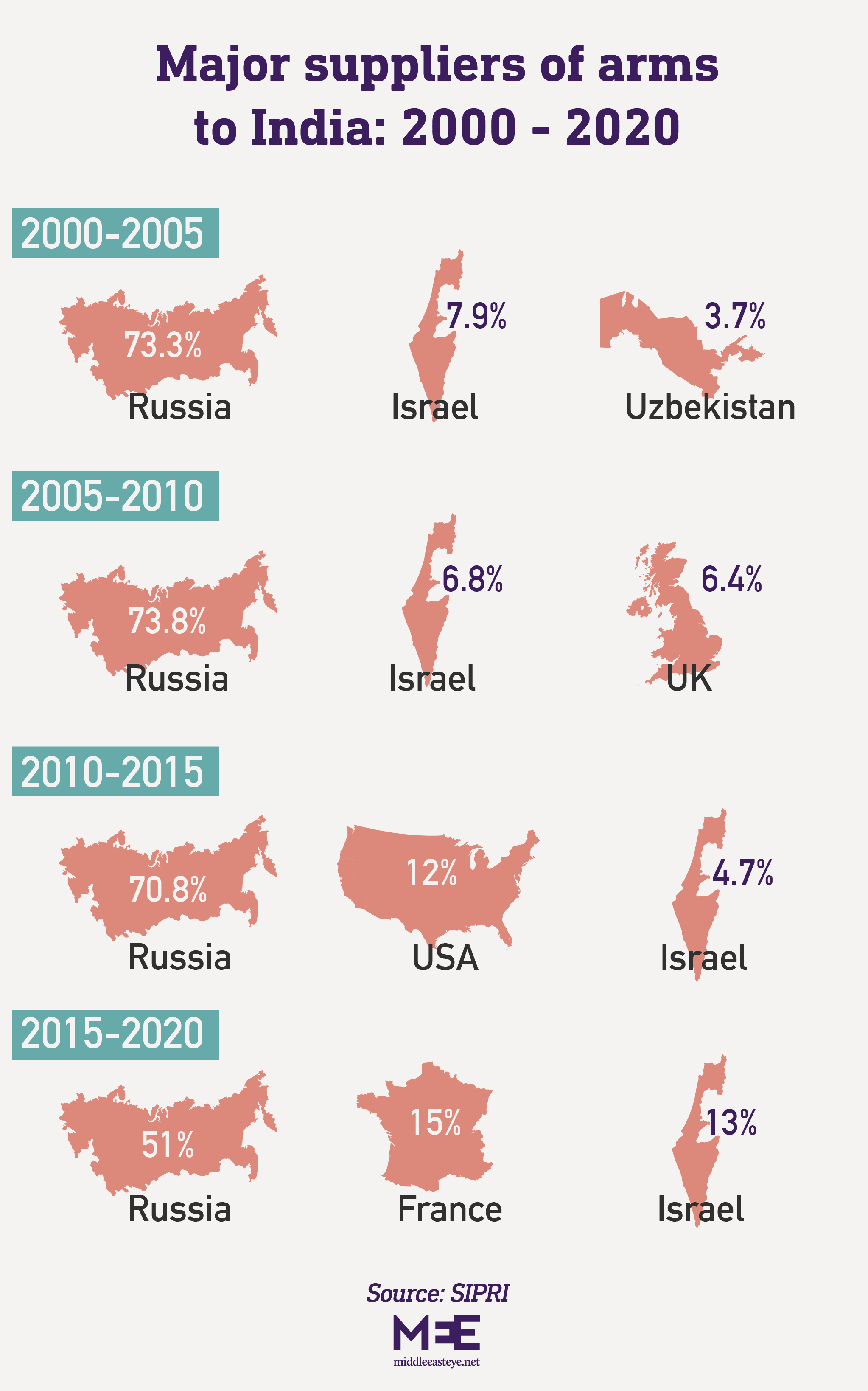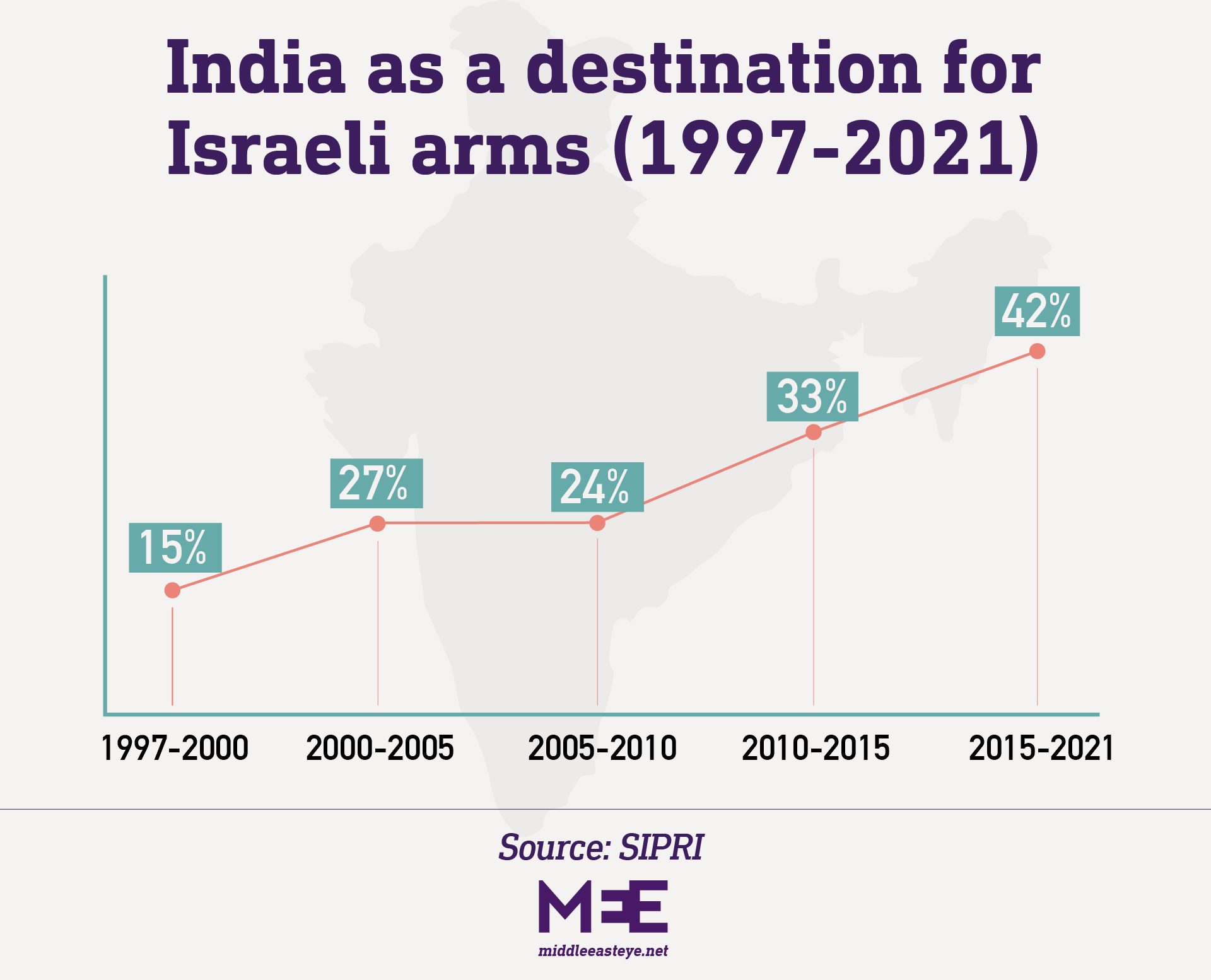India and Israel: The Arms Trade in Charts and Numbers
Since establishing ties in 1992, India has become Israel's biggest and most dependable purchaser of weapons

All Global Research articles can be read in 51 languages by activating the “Translate Website” drop down menu on the top banner of our home page (Desktop version).
To receive Global Research’s Daily Newsletter (selected articles), click here.
Visit and follow us on Instagram, Twitter and Facebook. Feel free to repost and share widely Global Research articles.
***
Israel’s defence minister Benny Gantz arrived in India’s capital this week to commemorate 30 years of diplomatic ties between the two countries.
Gantz met with his counterpart, Rajnath Singh, as well as with Prime Minister Narendra Modi, “with the aim of expanding and deepening cooperation between the establishments”.
Several other senior Israeli officials from the Defence Ministry’s Directorate for Defence Research and Development, as well as the Bureau of Political-Military Affairs, accompanied him on his trip, as well as representatives from Israel’s arms industries.
In recent years, the Israeli government has placed great importance on the Indian arms market as its largest and possibly most dependable customer of military hardware.
According to weapons monitors, India is the largest purchaser of Israeli-made arms, spending in excess of $1bn per year.
India, since 2017, has also become a strategic partner and a co-producer of Israeli weapons. Over the past five years, both countries have conducted joint military drills and hosted police and army training and exchange visits.
But it hasn’t always been this way. Until 1992, India did not have diplomatic relations with Israel.
The following graphics illustrate how India’s arms trade, and its relations with Israel, have changed over the past 30 years.
1. A brief history
Though military deals only proliferated once diplomatic ties were established, the countries did have clandestine relations before 1992.
Israel provided India with weapons in 1962 and then in 1965 in the wars against China and Pakistan. By the early 1970s, the Indian military establishment was impressed by and enamoured with Israeli technology.
Following several interactions between military leaders in the early 1990s, India agreed to assign a defence attache to Tel Aviv in 1995.
In 1999, Israel provided India with urgent assistance in its war with Pakistan, a move that established Israel as a reliable military partner.

2. Ties thaw after Cold War
Since the end of the Cold War, India has sought to diversify its weapon suppliers.
Russia remains its largest supplier, with the US, France and the UK remaining key suppliers, too. But it is India’s relationship with Israel that has demonstrated the most promise.
According to the Stockholm International Peace Research Institute (Sipri), India’s military expenditure in 2021 amounted to $76.6bn, the third-highest in the world, after the US and China. Between 2017-2021, India and Saudi Arabia were the world’s leading importers of arms, each accounting for 11 percent of global trade.
Increasing hostilities between India and China has also meant that a de facto arms race has emerged between the two countries.
In 2021, India and China accounted for around 63 percent of the entire military expenditure for the Asia and Oceania region.
“The economic effects of the Covid-19 pandemic have not ended the continuous upward trend in world military expenditure seen since 2015,” Sipri said in April.

3. India as a destination for Israeli arms
Between 1997 and 2000, 15 percent of all Israeli arms exports travelled to India. By the mid-2000s, this had increased to 27 percent, with India broadening its range of purchases, such as surveillance equipment, drones and surface-to-air-missiles. Between 2000 and 2010, India spent around $10bn on Israeli arms.
Since Prime Minister Narendra Modi entered office in 2014, around 42.1 percent of all arms exports from Israel have landed in India, with Azerbajiain (13.9 percent) and Vietnam (8.5 percent) and the United States (6.2 percent) making up the other major customers.
According to Sipri, weapons deliveries to India from Israel increased by 175 percent between 2015 and 2019.
Meanwhile, Israeli arms exports increased 19 percent between 2012-16 and 2017-2021. Its own spending on arms increased by 3.1 percent.
But the military relationship goes beyond military hardware. In 2019, after India fully annexed Indian-occupied Kashmir, a senior Indian diplomat in the US suggested India replicate the “Israeli model” in the territory, in reference to Israeli settlements in the occupied West Bank and East Jerusalem.
In 2020, India and Israel also signed an agreement to expand cooperation in cyber-security.
“Deepening cooperation with India is another important step in confronting global cyber threats,” Yigal Unna, director-general of Israel’s National Cyber Directorate (INCD), said at the time.
According to The Hindu, cyber-security “was identified as an important area of cooperation during Modi’s visit to Israel in July 2017”.
Earlier this year, a New York Times investigation alleged that it was during Modi’s 2017 visit that India procured the Pegasus software used to hack into the personal accounts of around 300 Indians, including activists, journalists and opposition leaders.

4. What weapons does India purchase from Israel?
The first purchases India made from Israel were two Super Dvora Mk II fast patrol boats in the mid-1990s.
Soon New Delhi began importing high-end defence equipment, including Israeli Searcher and Heron unmanned aerial vehicles (UAVs) and armed drones, missile systems, and sensors and electro-optical systems or Tavor assault weapons used by Indian Special Forces in Indian-occupied Kashmir.
Between 2014 and 2021, India received combat aircraft radar equipment, armed UAVs, anti-tank missiles and surface-to-air missiles, among other hardware from Israel. The Indian military is reportedly in possession of 108 Israeli Searcher drones and 68 unarmed Heron 1s. It also has several Harpy drones – also known as suicide attack drones.
“Israel has maintained its occupation of Palestinian lands for over 70 years, where millions of Palestinians live under military control and suspension of their civil rights. It is an apartheid and settler-colonial state, carrying out its illegal activities with impunity because of the support it receives from states and corporations,” said a 2020 report published by BDS India, in collaboration with People’s Dispatch and Newsclick.
Just as the Covid-19 pandemic began in early 2020, Modi’s government ordered 16,479 Negev light machine guns, sparking outrage among some Indian activists.
In its recent “surgical strikes” on Pakistan in 2019, India used Israeli-made “Spice 2000” bombs.
Last year, during the standoff with China, India leased and finally bought four Heron-TP Medium Altitude Long Endurance UAVs from Israel Aircraft Industries (IAI).

5. Co-production of arms
Over the past decade, India has prioritised the modernisation of its armed forces and laid significant emphasis on self-reliance in arms production, in line with Modi’s “Make in India” plan.
“In a drive to strengthen the indigenous arms industry, 64 percent of capital outlays in the 2021 Indian military budget were earmarked for acquisitions of domestically produced arms,” Sipri said.
As part of this drive, India has worked with Israel in co-producing weapons.
In 2017, Israel Weapons Industries and Indian construction company Punj Lloyd created the first private small arms factory in Malanpur, under the name Punj Lloyd Raksha Systems, or PLR Systems.
According to PLR Systems, also a joint venture with Adani Group and the SK Group, the factory produces the Tavor Assault Rifle, X95 Assault Rifle, Galil Sniper Rifle, Negev Light Machine Gun and the Uzi Sub Machine Gun used by the Indian military, including Indian Special Forces.
Later in 2017, Kalyani Rafael Advanced Systems Ltd (KRAS), a joint venture between India’s Kalyani Strategic Systems Ltd and Israel’s Rafael Advanced Systems, began manufacturing Spike anti-tank guided missiles for the Indian army.
It was the first private company to produce missiles in India.
In 2019, KRAS received an order of $100m to produce the Barak-8, a long-range surface-to-air missile, for the Indian navy.
“We at Rafael are proud of our role – not only in KRAS – but also of our participation in Make in India, and our strong relationship with the vibrant talent across India’s defence industries,” Retired Brigadier General Pini Yungman said in a statement.
In late 2021, the military ordered Skystriker drones. This will now be produced in a joint venture between Israel’s Elbit Systems and India’s Adani-owned Alpha Design Technologies, in the southern Indian city of Bengaluru.
“India’s good at large-scale things, like call centres and software development, but Israel’s doing package software. India’s doing back-office biotech research, but Israel actually has products that are out there in the global markets more than India does,” Richard Rossow, senior adviser and Wadhwani Chair in US-India Policy Studies at CSIS, told CNBC.
“So it could be Israeli companies looking for a larger production base, in which case India’s ready to go.”

*
Note to readers: Please click the share buttons above or below. Follow us on Instagram, Twitter and Facebook. Feel free to repost and share widely Global Research articles.
Featured image is from MEE

